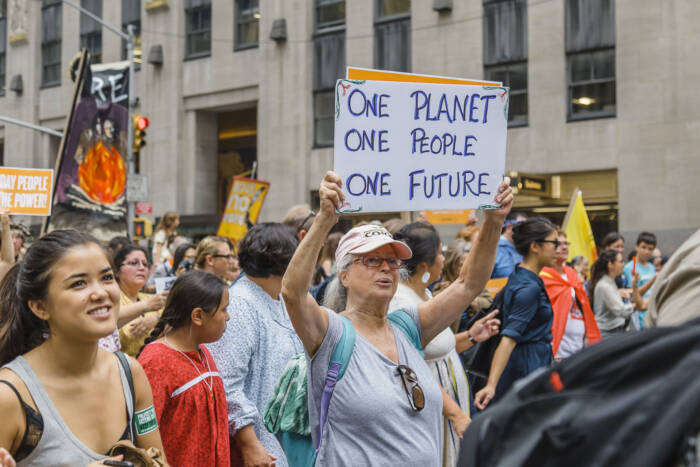To understand why, consider these numbers:
- 80% of those displaced by extreme weather events are women and girls. They are also 14 times more likely to die in climate disasters than men. Climate shocks force millions of girls out of school and into early marriage.
- Women produce up to 80% of food in developing countries, yet they receive a fraction of the resources—training, credit, and support—needed to adapt to climate change. When droughts or floods ruin harvests, it is women and girls who are most likely to go hungry.
- Indigenous women protect 80% of the world’s remaining rainforests, mangroves, and biodiversity hotspots. Their reward? Violence, displacement, and criminalization.
Women Are Leading Climate Solutions
Women and girls, however, are not just victims of the climate crisis—they are leaders, problem-solvers, and innovators. Across the world, women are stepping up to protect their communities, drive sustainable solutions, and demand climate justice.
Women Protecting Their Communities from Climate Disasters
In Bangladesh, where rising sea levels and stronger cyclones displace hundreds of thousands every year, women-led adaptation programs are making a difference. Women’s groups have spearheaded the construction of floating gardens—ingenious structures that allow communities to grow food on water, even as floodwaters rise. They have also led the development of cyclone shelters designed with women’s safety and needs in mind, ensuring that when disaster strikes, they have a secure place to go.
In India, Ahmedabad’s deadly heatwaves disproportionately affect the poorest residents, who live in tin-roofed homes that turn into ovens in extreme temperatures. Women in these communities took the lead in implementing a highly cost-effective solution: solar-reflective white paint. By painting rooftops white, they significantly reduced indoor temperatures, protecting their families from heatstroke and other health risks.
Women Driving Renewable Energy Solutions
Across Africa, women-led organizations are pushing for decentralized, community-driven renewable energy. In Mali, Solar Sister trains and supports women entrepreneurs to distribute solar-powered lamps and clean cookstoves in rural communities, reducing reliance on harmful and expensive kerosene lamps. This not only cuts carbon emissions but also improves women’s health by reducing indoor air pollution.
In Nepal, where deforestation threatens both the environment and the livelihoods of rural communities, women-led forest management groups are successfully regenerating degraded forests. These groups have shown that when women have decision-making power, forests are managed more sustainably, benefiting both people and nature.
Women in Politics: The Game Changers
Countries with more women in political leadership pass stronger environmental policies. Studies show that when women hold more seats in parliament, climate action is more ambitious and policies to protect natural resources are more robust.
One striking example comes from Rwanda, where women make up the majority of parliament. Under their leadership, the country has implemented some of the most progressive environmental policies in Africa, including a nationwide ban on plastic bags and strong investments in reforestation and sustainable land use.
In the Pacific Islands, women leaders have been at the forefront of international climate negotiations, pushing wealthier nations to take responsibility for their emissions. Former Marshall Islands President Hilda Heine, for example, played a key role in securing the Paris Agreement’s 1.5°C goal, emphasizing the existential threat that climate change poses to small island nations.
The Power of Educating Girls
Educating girls is a proven climate solution. Societies that invest in girls’ education are more resilient to climate shocks and have lower emissions. Education empowers women with the knowledge and resources to drive sustainable change in their communities, from adopting climate-smart agricultural techniques to advocating for environmental policies.
For example, in Ethiopia’s drought-prone regions, girls’ education programs have led to higher adoption of water conservation techniques, reducing the impact of droughts on farming communities. Research shows that if all girls completed secondary education, it could lead to significant reductions in global emissions over time, as education is closely linked to lower birth rates and more sustainable resource use.
Yet Women Still Lack Climate Funding
Despite their leadership, women receive just 0.01% of global climate finance for initiatives promoting gender equality and climate action. This is a glaring injustice. Women are driving the solutions we need, yet they are chronically underfunded.
If we are serious about solving the climate crisis, we must recognize that gender equality is not an optional add-on—it is fundamental to climate justice.
This International Women’s Day: A Call to Action
We cannot put out the fires consuming our planet while silencing the voices of those who could help douse the flames.
This International Women’s Day, let’s commit to a future where women stand as equal partners in building a thriving, sustainable world—where Mother Earth, and all her daughters and sons, can heal and flourish.
That means:
- Investing in women-led climate solutions
- Ensuring women have equal access to climate finance
- Supporting girls’ education as a climate priority
- Electing more women leaders who will champion climate action
The future of our planet depends on it.

Manhattan, New York, USA 窶� 21 September 2014: Woman carries a placard depicting 窶楼ne Planet, One, People, One Future窶� and protests against climate change at the People窶冱 Climate March along 6th Avenue.